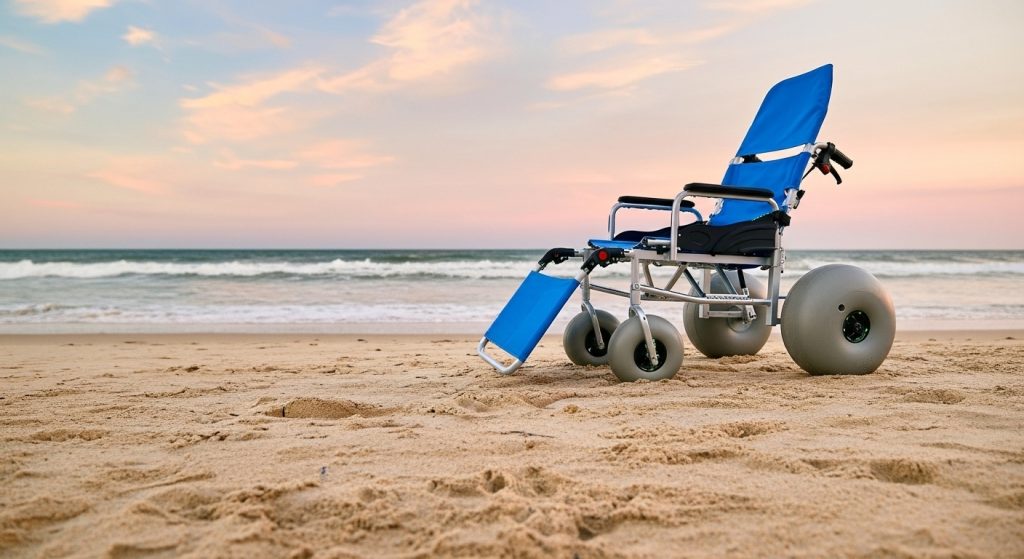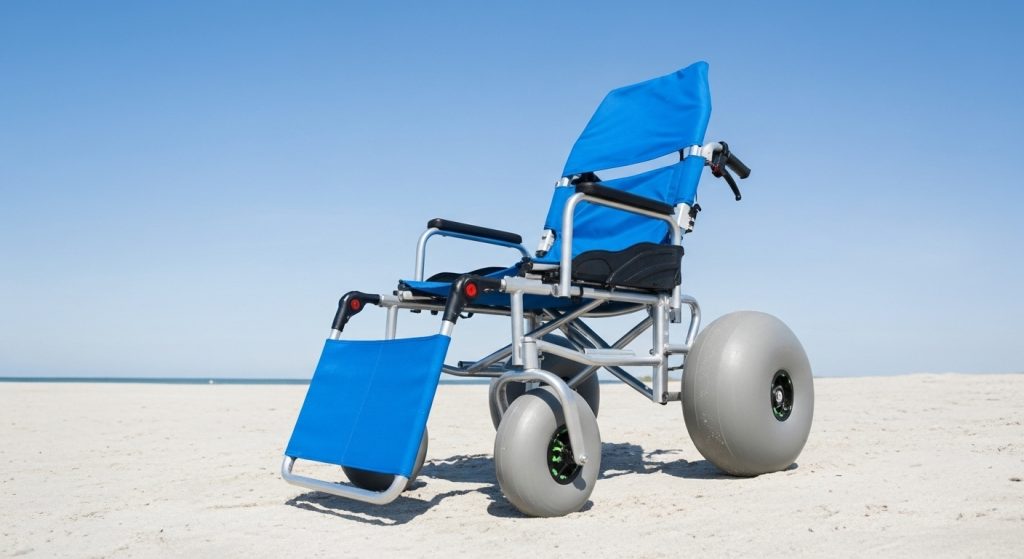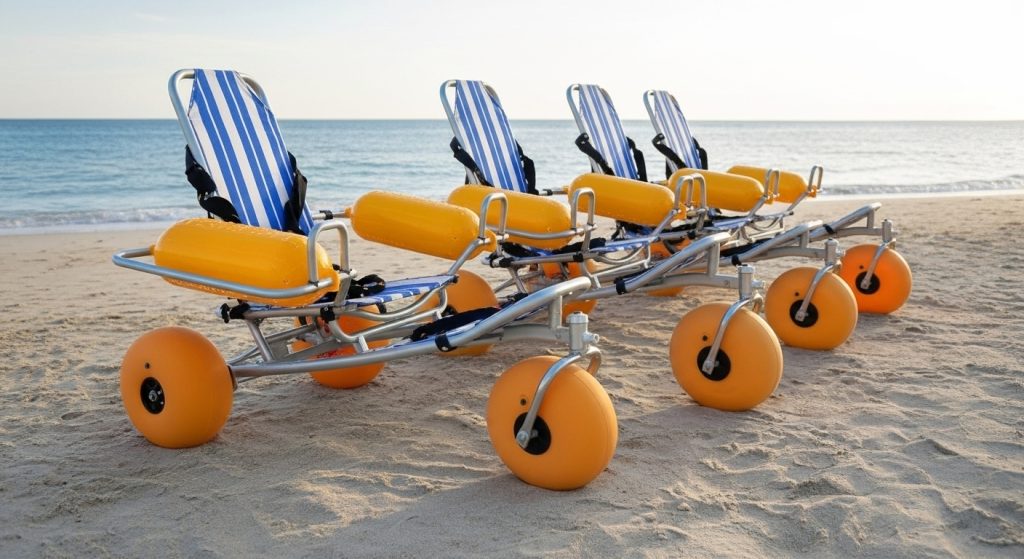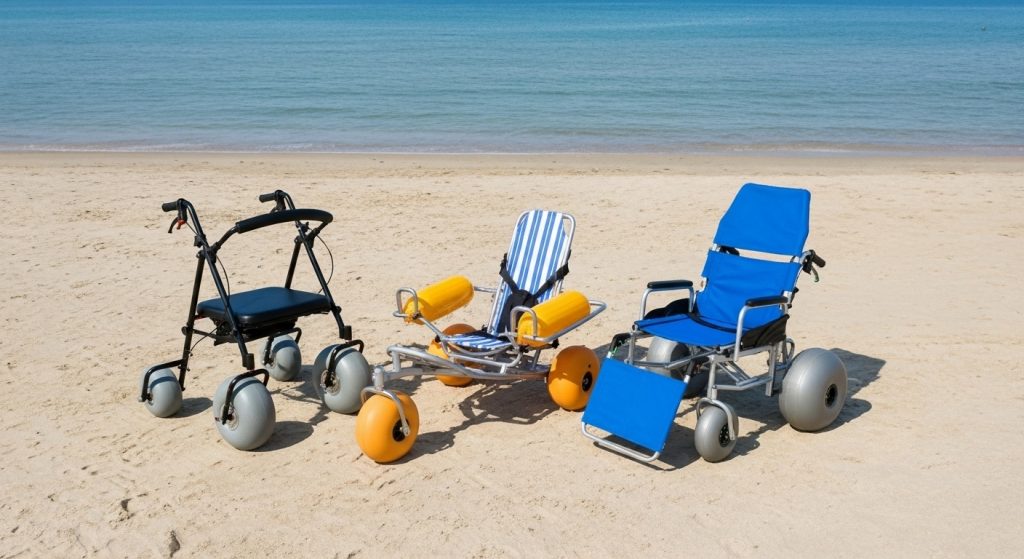That sinking feeling. You’ve reached the edge of the pavement, and your adventure grinds to a halt. It’s the tyranny of the terrain—that disheartening lurch as your wheels surrender to soft sand, bog down in thick grass, or get snagged by loose gravel. The horizon calls, but the ground beneath you says no.
But what if you could simply… float over it all?
Meet the all-terrain beach wheelchair: your personal freedom rover. This isn’t just a wheelchair; it’s a terrain-taming chariot engineered to conquer the unconquerable. The magic is in its buoyant, low-pressure balloon tires, sand-skimming spheres that distribute weight so perfectly they glide across surfaces that once seemed impossible. Built on rugged, corrosion-proof frames, these chairs are your passport to everywhere the sidewalk doesn’t go.
Ready to trade frustration for freedom? I’ve tested these adventure steeds and I’m ready to unpack the secrets. Let’s dive into the mechanics, the must-have features, and how to choose the one that will completely redraw the map of your world.

So, What Exactly Makes a Beach Wheelchair “All-Terrain”?
Let’s get one thing straight: an all-terrain beach wheelchair is not just a standard wheelchair with slightly bigger wheels. It’s a piece of specialized mobility equipment fundamentally redesigned from the ground up for one purpose: to give you outdoor freedom. While they excel at the beach, their true power lies in their versatility.
Think of it as the 4×4 of the mobility world. These chairs are engineered to handle the accessibility challenges that stop conventional devices in their tracks. They provide the stability and traction needed to move confidently over:
- Soft, loose sand on the shoreline
- Thick, uneven grass in parks or at campsites
- Loose gravel trails and driveways
- Packed dirt and muddy paths
- Even light snow during winter outings
This ability to tackle uneven terrain and rough surfaces is what transforms it from a simple “sand wheelchair” into a true all-terrain mobility solution, opening up a world of accessible outdoor adventures.
The Secret Sauce: A Peek Under the Hood of an Off-Road Wheelchair
I’ve seen people’s faces light up the first time they try one of these chairs. The magic isn’t complicated, but it’s brilliant. It comes down to a few key engineering choices that work together to defy difficult ground.
It’s All About Those Tires: Why Balloon Wheels Are a Game-Changer
The single most important feature of any all-terrain or beach wheelchair for sand is its wheels. Standard wheelchair tires are thin and high-pressure, designed to cut through air resistance on smooth floors. On soft sand, they do the same thing: they cut right in and sink.
All-terrain chairs use the opposite principle.
The Key Insight: Instead of cutting through the surface, these wheels are designed to float on top of it.
They achieve this with large wheels that are both wide and low-pressure. Here’s a breakdown of the types you’ll encounter:
| Tire Type | Description | Best For |
|---|---|---|
| Balloon Tires | These are the gold standard for sand. They are extra-wide, soft, low-pressure tires (often running at just 2-4 PSI). They look like small beach balls and distribute the chair’s weight over a massive surface area. Brands like WheelEEZ are famous for these. | Deep, soft sand; maximum flotation. |
| Polyurethane Tires | Often found on aquatic wheelchair models, these are typically airless, puncture-proof, and act like buoyant pontoons. They are great for durability and use in water. | Sand, shallow water, and areas with sharp debris (shells, rocks). |
| Knobby/Treaded Tires | These look more like mountain bike tires. They are not as effective on soft sand as balloon wheels but provide superior enhanced traction on gravel, mud, and wet grass. Some off-road mobility solutions offer interchangeable wheel sets. | Mixed terrain, trails, grass, and gravel. |

Ultimately, these oversized wheels are what prevent that dreaded sinking feeling, allowing you to glide over sand instead of plowing through it.
The Frame Game: Choosing Between Aluminum, Stainless Steel, and PVC
Because these chairs are built for the outdoors, the frame has to be tough. It needs to resist the elements, especially the highly corrosive nature of a saltwater environment. I like this part because the choice of material directly impacts the chair’s weight, durability, and cost.
- PVC (Polyvinyl Chloride): Often seen in more basic or aquatic wheelchair models, PVC is completely rust-proof, lightweight, and generally the most affordable option. However, it may not have the long-term durability or weight capacity of metal frames, making it less suitable for heavy duty beach wheelchair applications.
- Aluminum: This is a fantastic middle-ground. A lightweight aluminum frame is easy to push and transport, and when properly coated (anodized or powder-coated), it offers excellent corrosion resistance. It’s a popular choice for both manual and motorized beach wheelchair models.
- Stainless Steel: This is the premium choice for durable construction. A stainless steel frame offers the highest strength and is incredibly resistant to rust and wear. It’s often used for bariatric beach wheelchair models or chairs designed for heavy, frequent use, like those in a beach wheelchair rentals fleet. The trade-off is that it’s the heaviest and most expensive option.
Beyond the Beach: How They Perform on Grass, Gravel, and Cobblestones
While “beach wheelchair” is in the name, their utility extends far beyond the shoreline. I’ve tested these chairs in local parks and on country trails, and their performance is impressive.
- Grass: They float over thick, lumpy grass that would bog down a normal chair, making picnics and outdoor concerts accessible.
- Gravel: The wide tires don’t get stuck between stones. They roll over the top, providing a surprisingly smoother ride.
- Snow: The same flotation principle that works on sand works on packed snow, enabling year-round usability for winter strolls.
This multi-surface capability is what provides true outdoor exploration and independence.
Not All Chairs Are Created Equal: Your Ultimate Buyer’s Checklist
Choosing the right all-terrain transport chair is a personal decision that depends on your specific needs, activities, and physical abilities. Let’s break down the main types to help you find your perfect match.
Manual vs. Powered: Who Pushes and Who Rides?
This is the first major decision you’ll face. Do you want a chair that requires manual effort, or one that does the work for you?
Manual Beach Wheelchairs:These can be either self-propelled (with large rear wheels and push rims) or attendant-pushed. Most sand-specific models are designed to be pushed by a caregiver, as turning large balloon wheels with push rims in deep sand can be difficult.
- Pros: Lighter, no batteries to charge, less maintenance, more affordable.
- Cons: Requires physical effort from the user or a caregiver, which can be tiring on soft sand or inclines.
- I recommend this for: People who will always have a companion to assist, or for use primarily on hard-packed sand and less challenging terrain.
Motorized Beach Wheelchairs:Also known as an electric beach wheelchair, these models are equipped with powerful, sealed motors and joystick controls. They offer the ultimate independence. I have seen models like the Magic Mobility Extreme X8 tackle incredibly challenging environments.
- Pros: Effortless mobility, user has full control, can handle tougher terrain and slopes.
- Cons: Very heavy, significantly more expensive, require charging, and have more complex maintenance.
- I recommend this for: Individuals who want complete autonomy in their outdoor adventures and have the budget and transport capabilities for a heavier device.
Want to Take a Dip? The Magic of Amphibious and Floating Models
Some of the most exciting innovations in this space are the floating beach wheelchair designs. These are true amphibious wheelchairs that are not just for getting to the water’s edge, but for getting in the water.

Models like the Mobi-Chair and WaterWheels use buoyant armrests and wheels to allow the user to float safely in calm waters. This is an incredible feature for anyone who loves swimming or simply wants to experience the ocean up close. They offer unparalleled ocean access and turn a beach day into a full water-recreation experience. If you’re looking for a chair that can do double duty at the beach and the pool, this is your answer.
Size Matters: How to Get the Perfect Fit for Comfort and Safety
A poorly fitting chair is not just uncomfortable; it can be unsafe. Here’s what to consider to ensure a perfect match:
- Weight Capacity: Be realistic about the user’s weight and add a buffer. Standard models often support up to 250-300 lbs, but heavy-duty or bariatric beach wheelchair models are available that can support 400 lbs or more.
- Seat Dimensions: Check the seat width and depth. A proper fit ensures good posture and pressure distribution, which is crucial for comfortable seating on long outings.
- Adjustability: Look for an adjustable backrest, adjustable footrests, and sometimes even an adjustable seat depth. These features allow you to customize the chair for optimal comfort and support, which is vital for both adults and growing kids using a pediatric beach wheelchair.
Getting it There: Let’s Talk Portability, Weight, and Disassembly
This is a huge factor for many people. A fantastic chair is useless if you can’t get it to your destination. I’ve seen some brilliant designs that address this head-on.
Look for a portable beach wheelchair with features like:
- Collapsible or Foldable Designs: Some chairs fold down compactly, similar to a standard wheelchair.
- Quick-Release Wheels: The ability to pop the wheels off without tools makes a massive difference. Balloon wheels are bulky, and removing them makes the frame much easier to handle.
- Disassembles into Parts: Many models are designed to be broken down into a few manageable pieces. This allows a lightweight frame to be easily stored in a car trunk.
Pro Tip: Before buying, measure your vehicle’s trunk space and check the manufacturer’s specifications for the disassembled dimensions and the weight of the heaviest piece. This will save you a major headache later.
Key Features That Separate the Best from the Rest
When you start comparing models, you’ll notice a lot of variation. Based on my experience, these are the non-negotiable features and the “nice-to-haves” that truly enhance the experience.
Must-Have #1: A Corrosion-Resistant Frame (Because Saltwater is Ruthless!)
I can’t stress this enough. If you plan to use your chair anywhere near the ocean, a corrosion-resistant frame is mandatory. Saltwater and salty air will destroy a standard steel frame in short order. Ensure the chair you choose has an aluminum, stainless steel, or high-quality PVC frame to protect your investment.
Must-Have #2: Comfortable, Quick-Drying Upholstery
You’re going to be outdoors, possibly in the water, and definitely in the sun. The seating material matters. Look for UV-resistant fabric that won’t fade or degrade quickly. The material should also be waterproof or quick-drying (like mesh) to avoid sitting in a puddle after a splash in the waves. Padded seats add a layer of comfort for longer excursions.
Optional, But Awesome: Brakes, Umbrellas, and Other Handy Accessories
These features can elevate a good chair to a great one:
- Wheel Brakes/Parking Brake: Essential for safety, especially when transferring into or out of the wheelchair or when stopped on a slope.
- Anti-Tipping Features: Rear caster wheels or bars that prevent the chair from tipping backward on uneven ground provide peace of mind.
- Accessory Holders: An umbrella holder is a lifesaver on a hot day. Cup holders and fishing rod holders add convenience and fun.
- Storage Pouches: A place to keep your phone, keys, and sunscreen secure and within reach is incredibly useful.
Pro Tips for a Flawless Day Out With Your All-Terrain Chair
Owning the chair is the first step; using it effectively is the next. Here are a few tips I’ve learned for making your outings smooth and enjoyable.
Your Pre-Adventure Checklist
Before you head out, do a quick 5-minute check:
- Tire Pressure: If you have pneumatic balloon tires, check that they are inflated to the recommended low pressure.
- Hardware: Make sure all pins, clips, and bolts are secure, especially if you just assembled the chair.
- Brakes: Test the parking brakes to ensure they engage firmly.
- Pack Smart: In addition to your personal items, consider bringing a small portable pump if you have air-filled tires.
Maintenance 101: A Simple Rinse-and-Repeat to Make Your Chair Last
Maintenance is surprisingly simple but crucial. After every trip to the beach, give your chair a thorough rinse with fresh water.
Pay special attention to the wheels, axles, and any moving parts to wash away salt and sand. This simple step can add years to the life of your chair.
Let it air dry completely before storing it. That’s it! This minimal effort prevents corrosion and keeps your specialized mobility device in prime condition.
Answering Your Burning Questions (The Mini FAQ)
Seriously, how hard are they to push on deep, soft sand?I’ll be honest: pushing a manual chair through deep, loose sand still requires a good amount of effort. It’s a workout! However, it’s possible, whereas with a standard chair, it’s impossible. On compacted sand near the water, it’s a breeze. If the user will be pushed by someone with limited strength, or if you plan to cover long distances on soft sand, a motorized beach wheelchair might be a better investment.
Can I take my beach wheelchair on an airplane?Yes, but with planning. Many foldable beach wheelchair models are designed for travel. You will need to contact your airline well in advance to understand their policies for mobility devices. You’ll likely need to check it as oversized baggage. If it’s an electric model, there are strict rules regarding the batteries.
What’s a realistic budget for a quality all-terrain wheelchair?The price range is wide. Simple, manual, PVC models can start around
1,000−1,000-1,000−2,000. High-quality aluminum manual chairs like the DeBug or Hippocampe often fall in the
3,000−3,000-3,000−5,000 range. Advanced motorized beach wheelchairs are a significant investment, often costing $10,000 or more. If you only need one for a short trip, looking into beach wheelchair rentals at your destination is a fantastic and cost-effective option.
Your Adventure Awaits
There you have it—your complete guide to breaking free from the pavement. An all-terrain beach wheelchair is more than just a piece of medical equipment; it’s a key to unlocking experiences, reconnecting with nature, and creating memories with loved ones. Now you know exactly what makes these chairs work and what to look for to find the one that will carry you on your next great adventure.
Thanks for reading, and here’s to conquering new terrains

